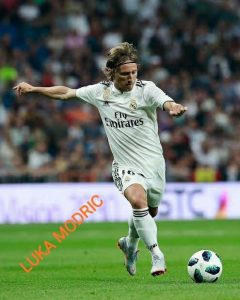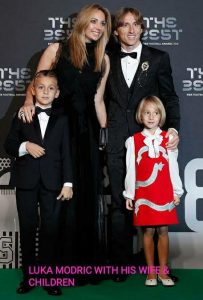ABOUT

Luka Modric born is a Croatian professional footballer born 9 September 1985 who plays as a midfielder for Spanish club Real Madrid and is the captain of the Croatia national team. Modric plays mainly as a central midfielder but can also play as an attacking midfielder or as a defensive midfielder, usually deployed as a deep-lying playmaker. Modric is widely regarded as one of the best midfielders of his generation, and among the greatest Croatian footballers of all-time. He is the captain of the Croatia national team and plays in well known Spanish club Real Madrid. He is regarded as the greatest Croatian footballer of all-time and one of the best midfielders of his generation.
| NAME | Luka Modric |
| DATE OF BIRTH | September 9, 1985 |
| AGE | 34 |
| PLACE OF BIRTH | Zadar, SR Croatia, SFR Yugoslavia |
| HEIGHT | 5 feet 8 inches |
| PLAYING POSITION | Midfielder |
| JERSEY NUMBER | 10 |
| CURRENT CLUB | REAL MADRID |
| NATIONALITY | Croatian |
Family & Personal Life
Luka Modric dated Vanja Bosnic for 4 years, before getting married to her in May 2010. The couple has three children: a son named Ivano and two daughters named Ema and Sofia.Luka has maintained a low profile outside his professional life. Modric grew up in Zadar, Croatia with his parents, Stipe Modric and Radojka Dopud. He has gone through a tough childhood as he lived a life of refugee for seven years when his house burnt down and had to flee to Hotel Kolovare. Later, Modric returned to Zadar and lived with his family.
Body Measurement-Modric stands tall with a height of 5 feet and 8 inches and weighs around 66 kilos. As a sportsperson, Modric has maintained his body figure well. Modric Croatia player has a light brown eye colour and is known for his long medium blonde hair .
CHILDHOOD & EARLY LIFE
Luka Modric was born on September 9, 1985, in Zadar, Croatia, to Radojka Dopud And Stipe Modric, His mother worked as a textile worker, and his father was an aeromechanic. The family’s financial conditions were below average, but they survived somehow.His parents were refugees who had fled from Serbian aggressors during the dreadful Bosnian War. He grew up amidst the Croatian War of Independence, which had taken its toll on his family’s financial situation.Due to the poor financial conditions of his parents, he spent most of his childhood at his grandparents’ house. He worked as a goat-shepherd at the age of 5. His grandfather was later executed by Serbian rebels. Their home was burned down, and as a result, the family was forced to flee the area.During those years of turmoil, his father joined the Croatian army. Bombs became the norm in the city of Zadar, where the family had shifted to. During that time, football was the best escape for the city’s youth, and Luka was not unaffected by it.Luka had been fascinated by football ever since he was a kid. He was short and thin for a kid his age, but he had a natural knack for playing football.He was consistently considered weak. Even during the youth trial at the ‘Hajduk Split,’ he was rejected. However, his skills did not go unnoticed for a long time. He worked hard to a point that he could no longer be ignored anymore.He was signed by the team ‘Dinamo Zagreb,’ as he showed steady growth in his height and frame. He eventually signed a 10-year contract.
CAREER
He was 16 when he was signed by ‘Dinamo Zagreb’ in 2002. He was selected after he performed well for his hometown club NK Zadar youth team. However, he was still considered too young to play in the senior club team. Thus, he was loaned to ‘Zrinjski Mostar’ in 2003 and to ‘Inter Zaprešić’ in 2004.Luka scored 12 goals in the 40 matches he played for the teams he was loaned to. It was not an exceptional goal-scoring record, but as a midfielder, it was an above-average performance. Hence, he was all set to make his debut for Dinamo in 2005.In 2012, Luka moved to one of the best football clubs in the world, Real Madrid. It turned out to be the most successful part of his career. His impeccable performance had him selected for the ‘Squad of the Season by the end of the 2013–2014 Champions League.He also played a massive role in his team winning three consecutive Champions League’ titles in the 2015–2016, the 2016–2017, and the 2017–2018 seasons. He was also named as part of the‘Squad of the Season in all three seasons.He won the ‘La Liga Award’ for the Best Midfielder in 2016 and the ‘UEFA Club Award’ for the ‘Best Midfielder’ in both 2017 and 2018. He also became the first Croatian footballer to be named to the ‘FIFA World XI’ teams in 2016 and 2018. He was also named to the ‘UEFA Team of the Year’ in the same years.In 2018, he became the first Croatian player to win the ‘UEFA Men’s Player of the Year Award.’ He has also received a ‘Ballon d’Or’ award
INTERNATIONAL CAREER
International career Luka first appeared in the national team of Croatia in March 2006, when Croatia went against Argentina. From then, he became part of the “Second Golden Generation.” He has managed to feature in all major fixtures and tournaments. In 2018’s World Cup Final game against France, he won “The Golden Ball” award after he was crowned the “Best Player.” Modric has won the “Croatian Footballer of the Year” for 11 years, from 2007 – 2018.
NET WORTH,SALARY,INCOME
Modric started his career in football when he played for the youth team of NK Zadar, but he made an immediate impact when he got loaned to Zrinjski Mostar in 2003. Toward the finish of the season, he was named Bosnian and Herzegovinian League Player of the Year. With his improving skills and abilities, Modric returned to Dinamo in 2005.
In the 2005-06 season, Modric signed a ten-year contract with the club and contributed the club to win the league. He played a total of 128 games for the club scoring 32 goals in his four seasons with the club. Following his streaks and extraordinary style of play, Modric turned into a hot focus of different clubs like Chelsea, Arsenal, and Barcelona. On 26th April 2008, he joined with Tottenham Hotspur for a six-year contract worth £16.5 million.


